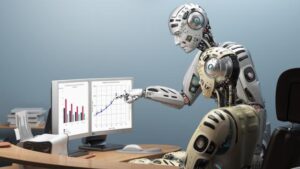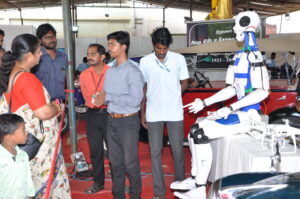Mechatronics Engineering
Mechatronics also called mechatronics engineering is an interdisciplinary branch of engineering that focuses on the integration of mechanical, electronic and electrical engineering systems and also includes a combination of robotics, electronics, computer science, telecommunications systems, control and product engineering.
To impart value based education to the students of Diploma in Mechatronics Engineering by developing their core competencies, technical, societal and ethical perception, thereby leading to an efficacious career or self employed.
M1: To enhance teaching learning experience through modern teaching methodologies, self learning and institute – industry interaction.
M2: To equip the students according to global needs of society to become innovators or entrepreneurs or professionals.
M3: To empower the students for enhanced performance through continues learning.
M4: To include moral and ethical values and focus on students overall development.
PEO1: Graduates of the programme will develop innovative and sustainable products in the field of Mechatronics engineering and allied engineering industries.
PEO2: Graduates of the programme will solve complex engineering problems by applying their technical knowledge and engage themselves in life long learing.
PEO3: Graduates of the programme will lead and contribute in a team entrusted with professional, social ethical responsible.
PSO1: Design and Develop cost effective modern techniques, tools, devices to Provide solution for Problems in industries
PO1:Basic and Discipline specific knowledge:
Apply knowledge of basic mathematics, science and engineering fundamentals and engineering specialization to solve the engineering problems.
PO2: Problem analysis:
Identify and analyze well-defined engineering problems using codified standard methods and interpret information gained to find solution.
PO3: Design/ development of solutions:
Design Mechatronics systems for various applications to meet specified needs.
PO4:. Engineering Tools, Experimentation and Testing:
Apply modern engineering tools/ computer software and appropriate technique to conduct standard tests and measurements.
PO5: Engineering practices for society, sustainability and environment:
Apply the impact of the Mechatronics engineering solutions in societal and environmental contexts, and demonstrate the knowledge and need for sustainable development.
PO6:Project Management:
Use engineering management principles effectively as an individual, and as a member or leader in diverse teams to manage projects and effectively communicate , both in writing and oral, about well-defined engineering activities.
PO7. Life-long learning:
Ability to analyze individual needs and engage in updating in the context of technological changes
through self learning and life – long learning.
Admission Procedure : Govt.Norms
Approved intake : 60
Course duration : 3 years
Study Mode : Full time
Course Level : Diploma
Course Approval : AICTE
MECHATRONICS ENGINEEIRNG COURSE SUMMARY
Mechatronics, is an interdisciplinary branch of engineering that focuses on the integration of mechanical engineering, electrical engineering, and software engineering, and also includes a combination of robotics, computer science, telecommunications, systems, control, and product engineering.
LABORATORIES
ELECTRONIC DEVICES AND CIRCUITS LABORATORY
ELECTRICAL CIRCUITS AND MACHINES AND DRIVES LABORATORY
MANUFACTURING TECHNOLOGY LABORATORY
CAD LABORATORY
ANALOG AND DIGITAL ELECTRONICS LABORATORY
INDUSTRIAL INSTRUMENTATION AND SENSORS LABORATORY
MICROCONTROLLER LABORATORY
INDUSTRIAL AUTOMATION LABORATORY
ROBOTICS LABORATORY
PROGRAMMING LANGUAGE LABORATORY
CNC LABORATORY
PROCESS CONTROL LABORATORY
ACADEMIC EXCELLENCE
- 100%placement in all academic year
- Alumni are placed in well reputed concern/organization.
- Best internships and industrial visits are provided for the students.
- New methodology for students to gain internet of thinks
DAB Members List


In fact, the term mechatronics is a fusion of mechanical and electronics engineering. That tells you that this kind of technology entails integration of both mechanical and electronics engineering concepts into a compact system.
Demand for Mechatronics Engineers is expected to go up, with an expected 19,920 new jobs filled by 2029. This represents an annual increase of 1.45 percent over the next few years.
There are currently an estimated 132,500 mechatronics engineers in the United States. The mechatronics engineer job market is expected to grow by 6.4% between 2016 and 2026.
Being relatively new as compared to the other fields of engineering, jobs in mechatronics are expected to grow. You will also find ample opportunities for internships with corporates, industry and government organisations. This career offers high-paying jobs and good starting salaries.
Advantages of Mechatronics course
- It is relatively new and less saturated.
- Numerous areas of applications.
- Versatility.
- Good job scope abroad.
Here are nine jobs you can easily opt for if you have a mechatronics degree
- Mechatronics technician
- Robotics engineer
- Automation engineer
- Instrumentation engineer
- Software engineer
- Electronics engineer
- Mechanical engineer
- Quality assurance engineer
Applications Of Mechatronics
You might be wondering about how exactly mechatronics is applied in advanced manufacturing. Here are some good examples:
- Production line automation: A manufacturing setting is designed as a chain process whereby one stage leads to the next. Most such systems use belts to move products and materials during the process. Mechatronics makes it possible to automate the process by incorporating devices like barcode readers, imaging and sound processors along the line. For example, a packaged product can have its manufacture and expiry dates stamped in and recorded while on the belt.
- Measuring devices: A manufacturing process is only good if the end products come out in the right shapes, sizes, weight, and quality. In that case, installing intelligent sensors, testing and calibration systems at the required points goes a long way in ensuring that. All this falls within the realm of mechatronics.
- Control systems: In any effective manufacturing line, there must be measures put in place to ensure that the installation operates at its optimum level. That makes dealing with factors like pressure and temperature a priority. Thanks to mechatronics, this can be done very easily through sensors and response mechanisms that work to monitor and maintain the desired operating conditions. For example, a sensor can trigger the turn on off the cooling system when the temperature builds to a certain degree.



